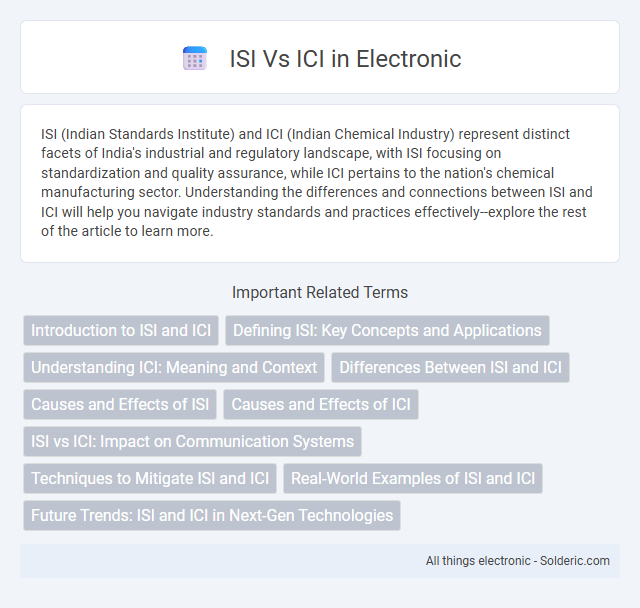ISI (Indian Standards Institute) and ICI (Indian Chemical Industry) represent distinct facets of India's industrial and regulatory landscape, with ISI focusing on standardization and quality assurance, while ICI pertains to the nation's chemical manufacturing sector. Understanding the differences and connections between ISI and ICI will help you navigate industry standards and practices effectively--explore the rest of the article to learn more.
Comparison Table
| Criteria | ISI (Indian Standards Institute) | ICI (Institute of Chemical Industry) |
|---|---|---|
| Full Form | Indian Standards Institute | Institute of Chemical Industry |
| Primary Function | Standardization and Certification of products | Research and development in chemical sciences |
| Founded | 1947 | Varies by country and institution, no singular founding year |
| Location | India | Multiple, depending on the institute |
| Scope | Standard setting across industries in India | Chemical research, education, and industrial innovation |
| Certification | Provides ISI Mark certification for products | Generally no certification; focus on R&D and publication |
| Authority | Now known as Bureau of Indian Standards (BIS) | Varies by organization |
| Impact | Ensures product quality and safety in India | Advances chemical industry technologies and education |
Introduction to ISI and ICI
In semiconductor fabrication, Ion Source Implantation (ISI) and Ion Cluster Implantation (ICI) represent two advanced doping techniques used to modify material properties. ISI utilizes a beam of single ions to implant dopants with precise control over depth and concentration, making it suitable for ultra-shallow junctions. ICI, on the other hand, employs clusters of ions that create more significant lattice damage and enhanced dopant activation, beneficial for achieving high doping levels in bulk materials.
Defining ISI: Key Concepts and Applications
ISI (Inter-Services Intelligence) is Pakistan's premier intelligence agency responsible for national security, intelligence gathering, and covert operations. It plays a significant role in counterterrorism, foreign intelligence, and strategic military advisories, often influencing regional geopolitics. The agency is known for its extensive network and collaboration with other global intelligence organizations to safeguard Pakistan's interests.
Understanding ICI: Meaning and Context
Intrapartum Cesarean Index (ICI) measures the rate of cesarean deliveries performed during labor, reflecting clinical decisions in real-time obstetric management. It contrasts with the Indication-Specific Incidence (ISI), which categorizes cesarean rates based on predefined medical reasons such as fetal distress or labor arrest. Understanding ICI provides crucial insights into labor progression dynamics and helps optimize cesarean intervention timing to improve maternal and neonatal outcomes.
Differences Between ISI and ICI
ISI (Inter Symbol Interference) occurs due to the overlapping of successive symbols in a digital communication channel, causing distortion in signal interpretation. ICI (Inter Carrier Interference) arises in multi-carrier systems, especially OFDM, when frequency offsets or Doppler shifts cause interference between adjacent subcarriers. Unlike ISI, which affects symbols over time, ICI impacts signals in the frequency domain, leading to degraded system performance in different modulation and channel conditions.
Causes and Effects of ISI
Import substitution industrialization (ISI) emerged as a strategy to reduce dependence on imported goods by fostering domestic industries, triggered by economic vulnerabilities exposed during global market downturns and trade restrictions. The implementation of ISI caused initial industrial growth and job creation but often resulted in inefficiencies, inflation, and balance of payments problems due to overreliance on protected markets and limited competition. These effects compelled many countries to later shift towards more open trade policies and export-oriented strategies like import competitive industrialization (ICI) to achieve sustainable economic development.
Causes and Effects of ICI
Inter-Carrier Interference (ICI) primarily results from Doppler shifts and frequency offsets in Orthogonal Frequency-Division Multiplexing (OFDM) systems, disrupting subcarrier orthogonality and causing signal distortion. The effects of ICI include reduced system performance, increased bit error rates, and degraded data throughput, which severely impact wireless communication reliability. Understanding and mitigating ICI is essential for maintaining your network's signal integrity and optimizing overall bitrate efficiency.
ISI vs ICI: Impact on Communication Systems
Inter-Symbol Interference (ISI) and Inter-Carrier Interference (ICI) are critical factors impacting communication systems by degrading signal quality and data integrity. ISI occurs when previous symbol transmissions overlap with the current symbol, causing distortion in time-domain signals, while ICI arises from frequency shifts and Doppler effects that disrupt orthogonality among subcarriers in multicarrier systems like OFDM. Minimizing ISI and ICI through advanced equalization techniques and robust modulation schemes is essential for optimizing Your system's bandwidth efficiency and error performance in wireless and wired communication networks.
Techniques to Mitigate ISI and ICI
Techniques to mitigate Inter-Symbol Interference (ISI) include equalization methods such as linear equalizers, decision feedback equalizers (DFE), and adaptive algorithms like LMS and RLS that compensate for channel distortions. Inter-Carrier Interference (ICI) is addressed by techniques such as frequency domain windowing, pilot-assisted channel estimation, and advanced algorithms like multi-carrier interference cancellation and iterative detection in OFDM systems. Combining channel coding with optimal modulation schemes further enhances system robustness against both ISI and ICI in wireless communications.
Real-World Examples of ISI and ICI
In telecommunications, ISI (Inter-Symbol Interference) and ICI (Inter-Carrier Interference) significantly impact signal quality in real-world scenarios such as high-speed wireless communications and OFDM (Orthogonal Frequency Division Multiplexing) systems. ISI occurs in channels with multipath propagation, causing overlapping symbols and degrading performance in digital TV broadcasting and DSL internet connections. ICI is prevalent in OFDM-based systems like LTE and Wi-Fi, where frequency offset or Doppler shift causes interference between subcarriers, reducing data throughput and increasing error rates.
Future Trends: ISI and ICI in Next-Gen Technologies
Future trends indicate that Inter Symbol Interference (ISI) mitigation techniques will increasingly leverage machine learning algorithms to enhance signal clarity in next-gen communication systems. Inter Carrier Interference (ICI) management is advancing through sophisticated adaptive filters and real-time frequency offset correction, critical for 5G and beyond wireless networks. Integration of ISI and ICI reduction strategies will be pivotal in achieving ultra-reliable low-latency communications (URLLC) and massive MIMO deployments.
ISI vs ICI Infographic

 solderic.com
solderic.com